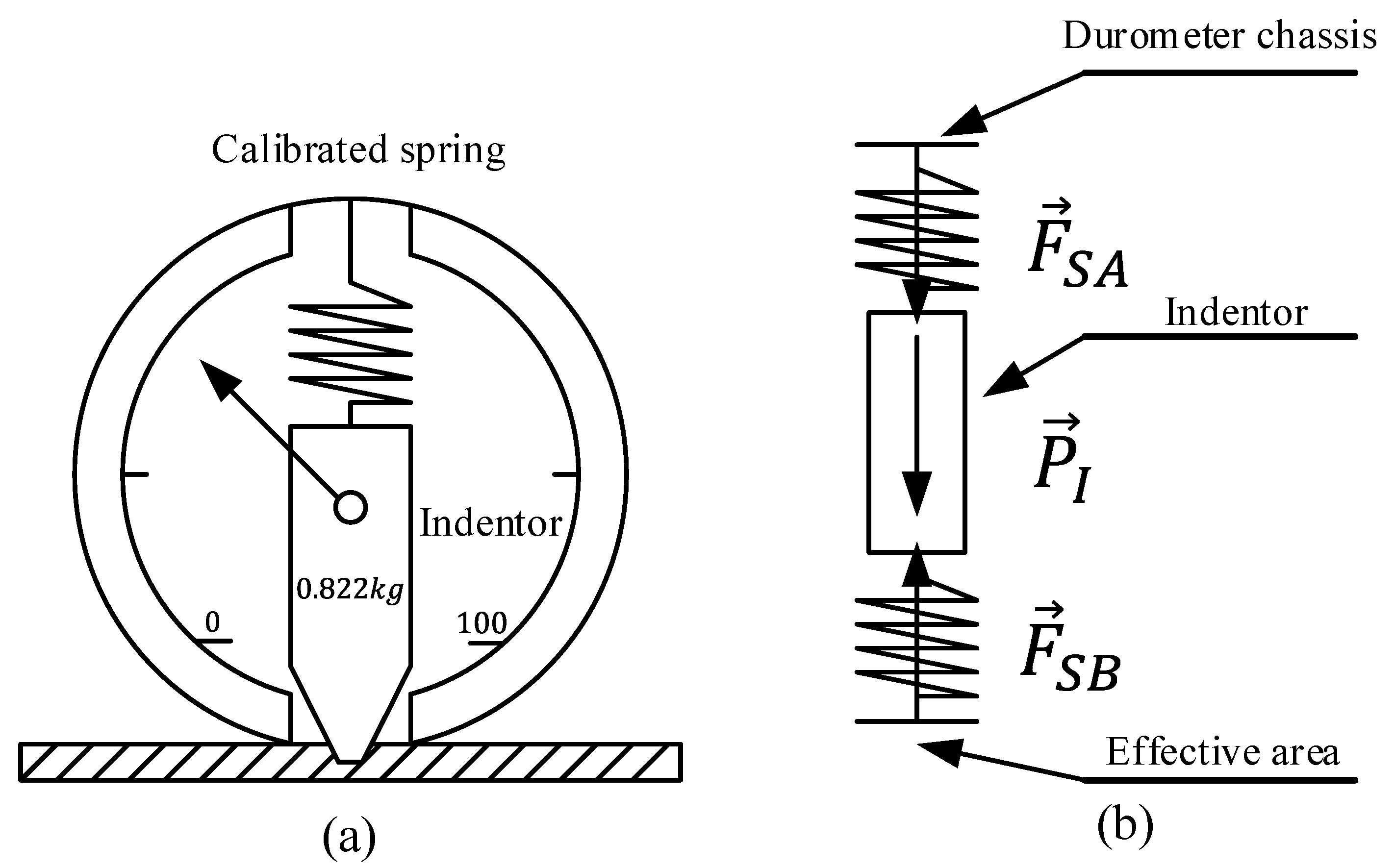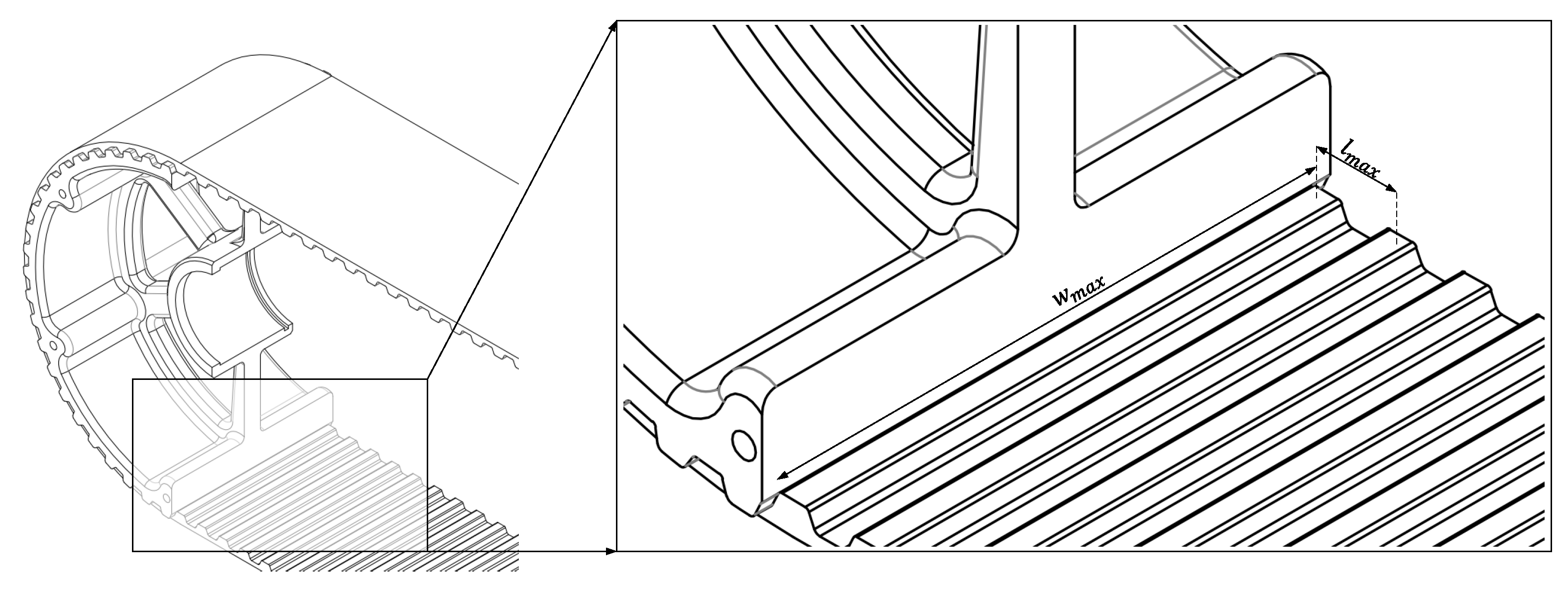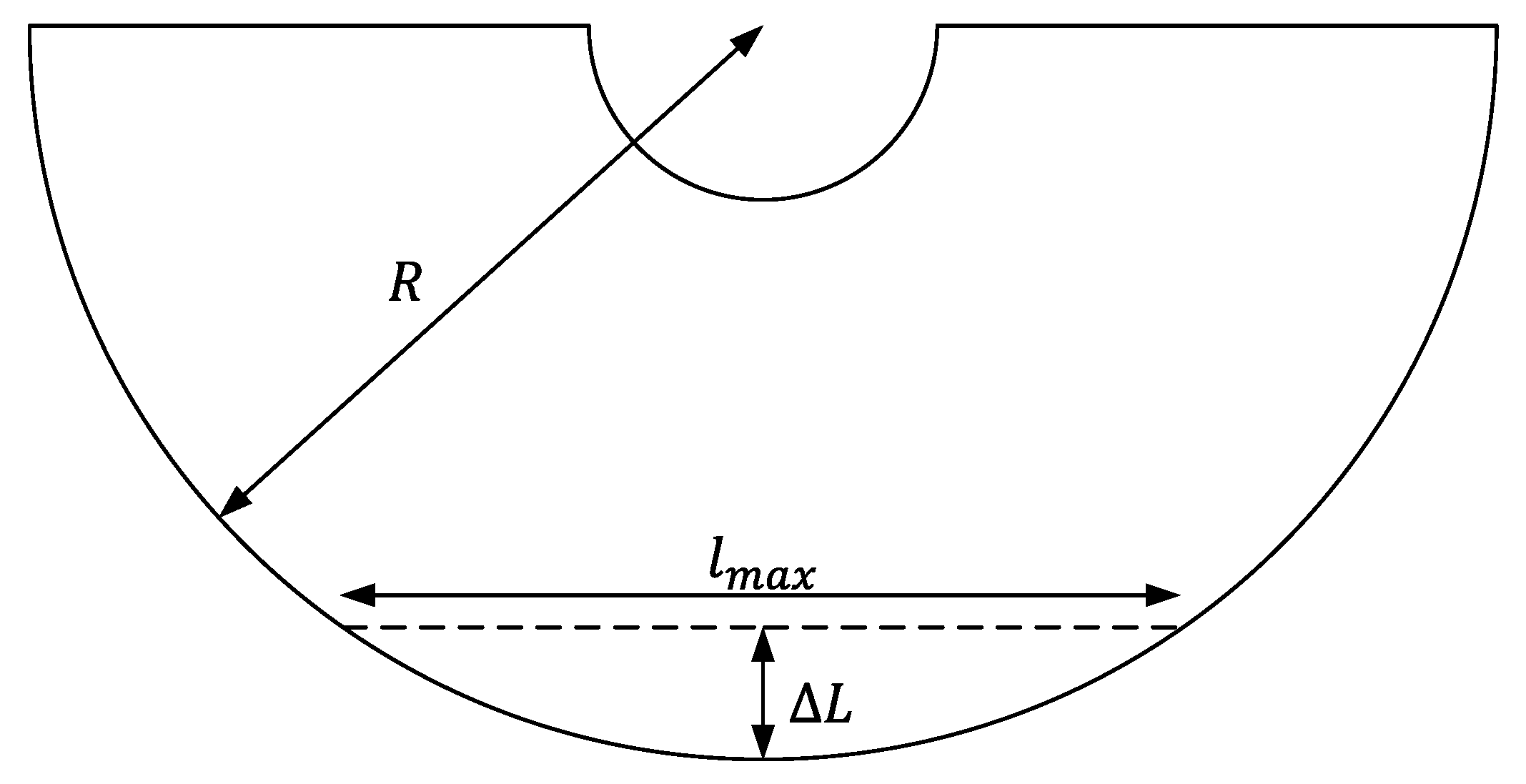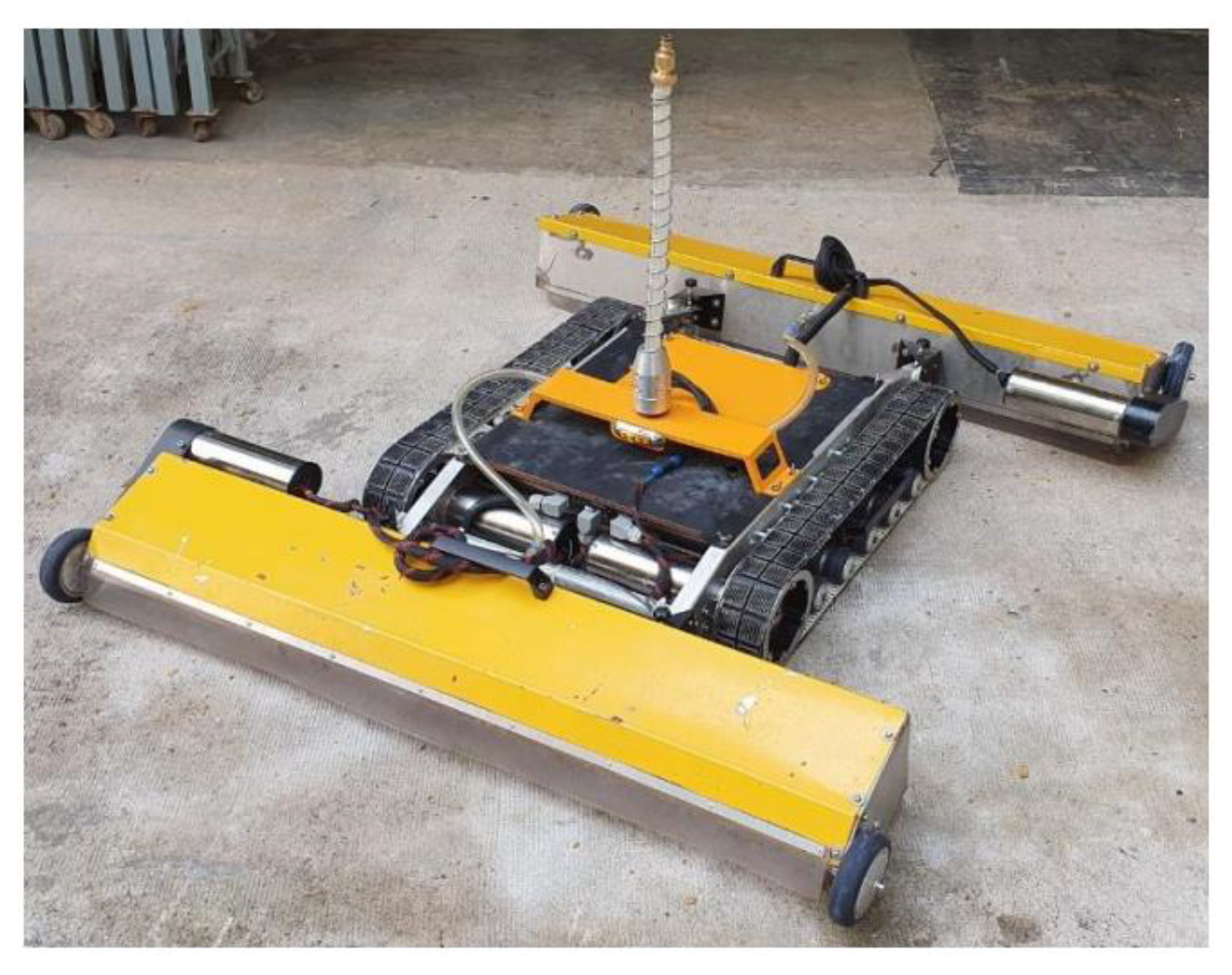Research on Adhesive Coefficient of Rubber Wheel Crawler on Wet Tilted Photovoltaic Panel
Abstract
:1. Introduction
2. Materials and Methods
- There is no slip on the primary timing pulleys and the PU timing belt;
- The tensions of the PU timing belts on both sides of the cleaning robot are the same;
- The slip resistance is not affected by the direction of rotation of the broom
3. Experimental Study
4. Conclusions
Author Contributions
Funding
Institutional Review Board Statement
Informed Consent Statement
Data Availability Statement
Acknowledgments
Conflicts of Interest
References
- Nacer, A.; Marhic, B.; Delahoche, L. Smart Home, Smart HEMS, Smart heating: An overview of the latest products and trends. In Proceedings of the 2017 6th International Conference on Systems and Control (ICSC), Batna, Algeria, 7–9 May 2017; pp. 90–95. [Google Scholar]
- Contreras, J.D.; Garcia, J.I.; Pastrana, J.D.D. Developing of industry 4.0 applications. Int. J. Online Eng. 2017, 13, 30–47. [Google Scholar] [CrossRef]
- Thoben, K.D.; Wiesner, S.A.; Wuest, T. ‘Industrie 4.0’ and smart manufacturing-a review of research issues and application examples. Int. J. Autom. Technol. 2017, 11, 4–16. [Google Scholar] [CrossRef] [Green Version]
- Kumar, A. Methods and Materials for Smart Manufacturing: Additive Manufacturing, Internet of Things, Flexible Sensors and Soft Robotics. Manuf. Lett. 2018, 15, 122–125. [Google Scholar] [CrossRef]
- Dilberoglu, U.M.; Gharehpapagh, B.; Yaman, U.; Dolen, M. The Role of Additive Manufacturing in the Era of Industry 4.0. Procedia Manuf. 2017, 11, 545–554. [Google Scholar] [CrossRef]
- Withagen, C. Pollution and exhaustibility of fossil fuels. Resour. Energy Econ. 1994, 16, 235–242. [Google Scholar] [CrossRef]
- Balat, A.M.; Ayar, G.; Oguzhan, C.; Uluduz, H.; Faiz, U. Influence of fossil energy applications on environmental pollution. Energy Sources Part Econ. Plan. Policy 2007, 2, 213–226. [Google Scholar] [CrossRef]
- Claußen, A.; Rosen, A. 30 Years Living with Chernobyl 5 Years Living with Fukushima Health Effects of the Nuclear Disasters in Chernobyl and Fukushima; IPPNW: Berlin, Germany; Physicians for Social Responsibility (PSR): Washington, DC, USA; PSR/IPPNW: Lucerne, Switzerland; IPPNW Austria (OMEGA): Wien, Austria, 2016. [Google Scholar]
- Loganovsky, K. DO low doses of ionizing radiation affect the human brain? Data Sci. J. 2009, 8, 13–35. [Google Scholar] [CrossRef]
- Bourguignon, D.; Scholz, N. Chernobyl 30 Years on: Environmental and Health Effects; European Parliamentary Research Service: Brussels, Belgium, 2016. [Google Scholar]
- Khare, V.; Khare, C.; Nema, S.; Baredar, P. Renewable energy system paradigm change from trending technology: A review. Int. J. Sustain. Energy 2021, 40, 697–718. [Google Scholar] [CrossRef]
- IEA. Renewables 2021; International Energy Agency: Paris, France, 2021; p. 167. [Google Scholar]
- He, G.; Zhou, C.; Li, Z. Review of self-cleaning method for solar cell array. Procedia Eng. 2011, 16, 640–645. [Google Scholar] [CrossRef] [Green Version]
- Kusch-Brandt, S. Urban Renewable Energy on the Upswing: A Spotlight on Renewable Energy in Cities in REN21’s “Renewables 2019 Global Status Report”. Resources 2019, 8, 139. [Google Scholar] [CrossRef] [Green Version]
- Jaradat, M.A.; Tauseef, M.; Altaf, Y.; Saab, R.; Adel, H.; Yousuf, N.; Zurigat, Y.H. A fully portable robot system for cleaning solar panels. In Proceedings of the 2015 10th International Symposium on Mechatronics and its Applications (ISMA), Sharjah, United Arab Emirates, 8–10 December 2015. [Google Scholar]
- National Renewable Energy Laboratory. Q4 2018/Q1 2019 Solar Industry Update; National Renewable Energy Laboratory: Golden, CO, USA, 2019; pp. 1–83.
- Maghami, M.R.; Hizam, H.; Gomes, C.; Radzi, M.A.; Rezadad, M.I.; Hajighorbani, S. Power loss due to soiling on solar panel: A review. Renew. Sustain. Energy Rev. 2016, 59, 1307–1316. [Google Scholar] [CrossRef] [Green Version]
- Sarver, T.; Al-Qaraghuli, A.; Kazmerski, L.L. A comprehensive review of the impact of dust on the use of solar energy: History, investigations, results, literature, and mitigation approaches. Renew. Sustain. Energy Rev. 2013, 22, 698–733. [Google Scholar] [CrossRef]
- Costa, S.C.S.; Diniz, A.S.A.C.; Kazmerski, L.L. Dust and Soiling Issues and Impacts Relating to Solar Energy Systems: Literature Review Update for 2012–2015. Renew. Sustain. Energy Rev. 2016, 63, 33–61. [Google Scholar] [CrossRef] [Green Version]
- Boyle, L.; Flinchpaugh, H.; Hannigan, M. Assessment of PM dry deposition on solar energy harvesting systems: Measurement-model comparison. Aerosol Sci. Technol. 2016, 50, 380–391. [Google Scholar] [CrossRef] [Green Version]
- Ahmed, O.K. Effect of dust on the performance of solar water collectors in Iraq. Int. J. Renew. Energy Dev. 2016, 5, 65–72. [Google Scholar] [CrossRef] [Green Version]
- Adinoyi, M.J.; Said, S.A.M. Effect of dust accumulation on the power outputs of solar photovoltaic modules. Renew. Energy 2013, 60, 633–636. [Google Scholar] [CrossRef]
- Al-Ammri, A.S.; Ghazi, A.; Mustafa, F. Dust effects on the performance of PV street light in Baghdad city. In Proceedings of the 2013 International Renewable and Sustainable Energy Conference (IRSEC), Ouarzazate, Morocco, 7–9 March 2013. [Google Scholar]
- Ronnaronglit, N.; Maneerat, N. A cleaning robot for solar panels. In Proceedings of the 2019 5th International Conference on Engineering, Applied Sciences and Technology (ICEAST), Luang Prabang, Laos, 2–5 July 2019; pp. 1–4. [Google Scholar]
- Al-Housani, M.; Bicer, Y.; Koç, M. Assessment of various dry photovoltaic cleaning techniques and frequencies on the power output of CdTe-type modules in dusty environments. Sustainability 2019, 11, 2850. [Google Scholar] [CrossRef] [Green Version]
- Kaldellis, J.; Zafirakis, D. Experimental investigation of the optimum photovoltaic panels’ tilt angle during the summer period. Energy 2012, 38, 305–314. [Google Scholar] [CrossRef]
- Yadav, A.K.; Chandel, S.S. Tilt angle optimization to maximize incident solar radiation: A review. Renew. Sustain. Energy Rev. 2013, 23, 503–513. [Google Scholar] [CrossRef]
- Rowlands, I.H.; Kemery, B.P.; Beausoleil-Morrison, I. Optimal solar-PV tilt angle and azimuth: An Ontario (Canada) case-study. Energy Policy 2011, 39, 1397–1409. [Google Scholar] [CrossRef]
- Makmee, T.; Pengwang, E. Design and Experiment of Four-side Stretch Slingbased Solar Cleaning Robot. In Proceedings of the 2021 7th International Conference on Engineering, Applied Sciences and Technology (ICEAST), Pattaya, Thailand, 1–3 April 2021; pp. 182–189. [Google Scholar]
- Anderson, M.; Grandy, A.; Hastie, J.; Sweezey, A.; Ranky, R.; Mavroidis, C.; Markopoulos, Y.P. Robotic device for cleaning photovoltaic panel arrays. In Proceedings of the International Conference on Climbing and Walking Robots (CLAWAR 2009), Istanbul, Turkey, 9–11 September 2009; pp. 367–377. [Google Scholar]
- Sorndach, T.; Pudchuen, N.; Srisungsitthisunti, P. Rooftop Solar Panel Cleaning Robot Using Omni Wheels. In Proceedings of the 2018 2nd International Conference on Engineering Innovation (ICEI), Bangkok, Thailand, 5–6 July 2018; pp. 7–12. [Google Scholar]
- Appels, R.; Lefevre, B.; Herteleer, B.; Goverde, H.; Beerten, A.; Paesen, R.; Medtsa, K.D.; Driesena, J.; Poortmans, J. Effect of soiling on photovoltaic modules. Sol. Energy 2013, 96, 283–291. [Google Scholar] [CrossRef]
- García, M.; Marroyo, L.; Lorenzo, E.; Pérez, M. Soiling and other optical losses in solar-tracking PV plants in navarra. Prog. Photovoltaics Res. Appl. 2011, 19, 211–217. [Google Scholar] [CrossRef] [Green Version]
- Kalogirou, S.A.; Agathokleous, R.; Panayiotou, G. On-site PV characterization and the effect of soiling on their performance. Energy 2013, 51, 439–446. [Google Scholar] [CrossRef]
- Moharram, K.A.; Abd-Elhady, M.S.; Kandil, H.A.; El-Sherif, H. Influence of cleaning using water and surfactants on the performance of photovoltaic panels. Energy Convers. Manag. 2013, 68, 266–272. [Google Scholar] [CrossRef]
- Bahaidarah, H.; Subhan, A.; Gandhidasan, P.; Rehman, S. Performance evaluation of a PV (photovoltaic) module by back surface water cooling for hot climatic conditions. Energy 2013, 59, 445–453. [Google Scholar] [CrossRef]
- Smith, M.K.; Selbak, H.; Wamser, C.C.; Day, N.U.; Krieske, M.; Sailor, D.J.; Rosenstiel, T.N. Water cooling method to improve the performance of field-mounted, insulated, and concentrating photovoltaic modules. J. Sol. Energy Eng. 2014, 136, 034503. [Google Scholar] [CrossRef]
- Krauter, S. Increased electrical yield via water flow over the front of photovoltaic panels. Sol. Energy Mater. Sol. Cells 2004, 82, 131–137. [Google Scholar] [CrossRef]
- Odeh, S.; Behnia, M. Improving photovoltaic module efficiency using water cooling. Heat Transf. Eng. 2009, 30, 499–505. [Google Scholar] [CrossRef]
- Kim, D.J.; Hyun, D.; Bhattarai, S.; Oh, J.H. Simulation and model validation of the surface cooling system for improving the power of a photovoltaic module. J. Sol. Energy Eng. 2011, 133, 041012. [Google Scholar] [CrossRef]
- Al-Jawah, M. A Decision Aiding Framework for Investing in Cleaning Systems for Solar Photovoltaic (PV) Power Plants in Arid Regions. Ph.D. Thesis, George Washington University, Washington, DC, USA, 2014; p. 207. [Google Scholar]
- Ting, Y.-C.; Chao, C.-H. Photovoltaic Device with Debris Cleaning Assembly. U.S. Patent Application No. 14/082,361, 31 July 2014. [Google Scholar]
- Librandi, H.Y.G.; Narain, J. Autonomous Photovoltaic Panels Cleaning System. Auton. Photovolt. Panel Clean. Syst. 2012, 2, 6–22. [Google Scholar]
- Lee, H.-L. Automatic Cleaning System for Solar Panels and Method Thereof. U.S. Patent No. 8,323,421, 4 December 2012. [Google Scholar]
- Singh, S.C.; Ravi, T. Sun Tracking Mechanism with Automated Cleaning Arrangement for Solar Panel. U.S. Patent No. 8,650,693, 18 February 2014. [Google Scholar]
- Lamont, L.A.; Chaar, L.E. Enhancement of a stand-alone photovoltaic system’s performance: Reduction of soft and hard shading. Renew. Energy 2011, 36, 1306–1310. [Google Scholar] [CrossRef]
- Deutsche Gesellschaft für Sonnenenergie (DGS). Planning and Installing Photovoltaic Systems a Guide for Installers, Architects and Engineers; Deutsche Gesellschaft für Sonnenenergie: Berlin, Germany, 2013. [Google Scholar]
- Mani, M.; Pillai, R. Impact of dust on solar photovoltaic (PV) performance: Research status, challenges and recommendations. Renew. Sustain. Energy Rev. 2010, 14, 3124–3131. [Google Scholar] [CrossRef]
- Yuyi, Z.; Yu, Z.; Huanxin, L.; Yunjia, L.; Liang, L. Control system design for a surface cleaning robot: Regular paper. Int. J. Adv. Robot. Syst. 2013, 10, 1–5. [Google Scholar] [CrossRef]
- Nguyen, D.P.N.; Lauwaert, J. Calculating the energy yield of si-based solar cells for belgium and vietnam regions at arbitrary tilt and orientation under actualweather conditions. Energies 2020, 13, 3180. [Google Scholar] [CrossRef]
- Bakirci, K. General models for optimum tilt angles of solar panels: Turkey case study. Renew. Sustain. Energy Rev. 2012, 16, 6149–6159. [Google Scholar] [CrossRef]
- Breyer, C.; Schmid, J. Global Distribution of optimal Tilt Angles for fixed tilted PV Systems. In Proceedings of the 25th EU PVSEC/WCPEC-5, Valencia, Spain, 6–10 September 2010. [Google Scholar]
- Li, Z.; Liu, X.; Tang, R. Optical performance of inclined south-north single-axis tracked solar panels. Energy 2010, 35, 2511–2516. [Google Scholar] [CrossRef]
- Jacobson, M.Z.; Jadhav, V. World estimates of PV optimal tilt angles and ratios of sunlight incident upon tilted and tracked PV panels relative to horizontal panels. Sol. Energy 2018, 169, 55–66. [Google Scholar] [CrossRef]
- Leine, R.I. Experimental and theoretical investigation of the energy dissipation of a rolling disk during its final stage of motion. Arch. Appl. Mech. 2009, 79, 1063–1082. [Google Scholar] [CrossRef] [Green Version]
- Saux, C.L.; Leine, R.I.; Glocker, C. Dynamics of a rolling disk in the presence of dry friction. J. Nonlinear Sci. 2005, 15, 27–61. [Google Scholar] [CrossRef] [Green Version]
- Güémez, J.; Fiolhais, M. Forces on wheels and fuel consumption in cars. Eur. J. Phys. 2013, 34, 1005–1013. [Google Scholar] [CrossRef] [Green Version]
- Smart, J.R.; Beimfohr, S.; Leighton, D.T. Measurement of the translational and rotational velocities of a noncolloidal sphere rolling down a smooth inclined plane at low Reynolds number. Phys. Fluids A 1992, 5, 13–24. [Google Scholar] [CrossRef]
- Shi, B.; Xiong, L.; Yu, Z. Pressure estimation based on vehicle dynamics considering the evolution of the brake linings’ coefficient of friction. Actuators 2021, 10, 76. [Google Scholar] [CrossRef]
- Batista, M. Steady motion of a rigid disk of finite thickness on a horizontal plane. Int. J. Non. Linear. Mech. 2006, 41, 605–621. [Google Scholar] [CrossRef] [Green Version]
- Bhushan, B. Tribology and Mechanics of Magnetic Storage Devices; Springer: New York, NY, USA, 1990. [Google Scholar]
- Pennestrì, E.; Rossi, V.; Salvini, P.; Valentini, P.P. Review and comparison of dry friction force models. Nonlinear Dyn. 2016, 83, 1785–1801. [Google Scholar] [CrossRef]
- ASTM D2240-15; Standard Test Method for Rubber Property—Durometer Hardness. American Society for Testing and Materials: West Conshohocken, PA, USA, 2021. [CrossRef]
- Mohan, R.; Das, B.N.; Sundaresan, R. Effect of hardness and surface roughness on slip resistance of rubber. J. Test. Eval. 2015, 43, 1574–1586. [Google Scholar] [CrossRef]
- Larson, K. Can You Estimate Modulus from Durometer Hardness for Silicones? Dow Corning: Midland, MI, USA, 2016; pp. 1–6. [Google Scholar]
- Heindl, R.A.; Mong, L.E. Young’s modulus of elasticity, strength, and extensibility of refractories in tension. J. Res. Natl. Bur. Stand. 1936, 17, 463. [Google Scholar] [CrossRef]
- Shen, C.; Rawls, H.R.; Esquivel-Upshaw, J. Phillips’ Science of Dental Materials; Elsevier: Amsterdam, The Netherlands, 2021. [Google Scholar]








| Parameters | Value | Parameters | Value |
|---|---|---|---|
| Material | Polyurethane (PU) | Coated material | Synthetic/Red rubber |
| Tooth profile | T10 | Coated trackpad | Cuboidal back profile |
| Width | 75 mm | Shore hardness | A35/A40 |
| Length | 1690 mm | Deep recessed | Only block/Zigzag pattern |
| Thinkness | 20 mm |
| Material | Shore Hardness | Maximum Tilted Angle |
|---|---|---|
| Synthetic rubber | Shore A30 | 30 |
| Red rubber | 28 | |
| Synthetic rubber | Shore A35 | 25 |
| Red rubber | 21 | |
| Synthetic rubber | Shore A40 | 18 |
| Red rubber | 15 | |
| Synthetic rubber | Shore A45 | 11 |
| Red rubber | 7 | |
| Synthetic rubber | Shore A50 | 3 |
| Red rubber | 0 |
| Material | Tilted Angle | Maximum Shore Hardness |
|---|---|---|
| Synthetic rubber | 30 | A30 |
| Red rubber | A28 | |
| Synthetic rubber | 25 | A35 |
| Red rubber | A32 | |
| Synthetic rubber | 20 | A39 |
| Red rubber | A36 | |
| Synthetic rubber | 15 | A42 |
| Red rubber | A40 |
Publisher’s Note: MDPI stays neutral with regard to jurisdictional claims in published maps and institutional affiliations. |
© 2022 by the authors. Licensee MDPI, Basel, Switzerland. This article is an open access article distributed under the terms and conditions of the Creative Commons Attribution (CC BY) license (https://creativecommons.org/licenses/by/4.0/).
Share and Cite
Nguyen, M.T.; Truong, C.T.; Nguyen, V.T.; Duong, V.T.; Nguyen, H.H.; Nguyen, T.T. Research on Adhesive Coefficient of Rubber Wheel Crawler on Wet Tilted Photovoltaic Panel. Appl. Sci. 2022, 12, 6605. https://doi.org/10.3390/app12136605
Nguyen MT, Truong CT, Nguyen VT, Duong VT, Nguyen HH, Nguyen TT. Research on Adhesive Coefficient of Rubber Wheel Crawler on Wet Tilted Photovoltaic Panel. Applied Sciences. 2022; 12(13):6605. https://doi.org/10.3390/app12136605
Chicago/Turabian StyleNguyen, Minh Tri, Cong Toai Truong, Vu Thinh Nguyen, Van Tu Duong, Huy Hung Nguyen, and Tan Tien Nguyen. 2022. "Research on Adhesive Coefficient of Rubber Wheel Crawler on Wet Tilted Photovoltaic Panel" Applied Sciences 12, no. 13: 6605. https://doi.org/10.3390/app12136605
APA StyleNguyen, M. T., Truong, C. T., Nguyen, V. T., Duong, V. T., Nguyen, H. H., & Nguyen, T. T. (2022). Research on Adhesive Coefficient of Rubber Wheel Crawler on Wet Tilted Photovoltaic Panel. Applied Sciences, 12(13), 6605. https://doi.org/10.3390/app12136605






